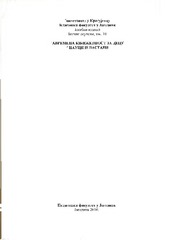Prikaz osnovnih podataka o dokumentu
Персонификација и антропоцентризам : онтогенетски приступ
Personification and Anthropocentrism
| dc.creator | Радић, Јованка | |
| dc.date.accessioned | 2020-12-31T16:51:42Z | |
| dc.date.available | 2020-12-31T16:51:42Z | |
| dc.date.issued | 2010 | |
| dc.identifier.isbn | 978-86-7604-093-3 | |
| dc.identifier.uri | https://dais.sanu.ac.rs/123456789/10212 | |
| dc.description.abstract | Полази се од запажања да примери оног што се назива персонификација обично не подразумевају својства која се приписују само човеку, већ сваком живом створу. У чињеници да се упркос томе стара дефиниција персонификације вековима не преиспитује, препознаје се антропоцентризам као стабилна - трајна и универзална карактеристика свести одраслих људских јединки. Показује се да је таква свест несвојствена детету млађег школског узраста, због чега оно или не препознаје (и не разуме) исказе са персонификацијом, или их не прихвата као смислене и ваљане. | sr |
| dc.description.abstract | The research is based on the remark that the examples of the “stylistic figure” called personification do not usually imply the characteristics of a human being, but of every living creature. This means that personification (humanization, representation), which dates back from the ancient times, depicts a mind prone to adapting and proclaiming human all the characteristics we share with all other living creatures. As a consequence of this remark and the fact that the set definition of personification has not been reviewed for centuries, one can recognize anthropocentrism as a stable-permanent and universal characteristic of an adult mind. On the other hand, one can see that that kind of mind does not control the way a younger pupil thinks, who, therefore, either does not recognize (and understand) constructions with personification, or accepts them as senseless and improper. Children’s reaction to the sentence The painting must speak show that prevailing of animism during the seventh year does not imply a more relevant convergence to anthropocentrism and the opposition, represented grammatically in this couple of pronouns WHO ‘human’ — WHAT ‘non-human’. | sr |
| dc.language.iso | sr | sr |
| dc.publisher | Јагодина : Педагошки факултет | sr |
| dc.relation | info:eu-repo/grantAgreement/MESTD/Basic Research (BR or ON)/178030/RS// | sr |
| dc.rights | openAccess | sr |
| dc.rights.uri | https://creativecommons.org/licenses/by-nc-nd/4.0/ | |
| dc.source | Савремена књижевност за децу у науци и настави : зборник радова | sr |
| dc.subject | персонификација; антропоцентризам; опозиција људско - нељудско; категорија; онтогенеза | sr |
| dc.title | Персонификација и антропоцентризам : онтогенетски приступ | sr |
| dc.title | Personification and Anthropocentrism | sr |
| dc.type | bookPart | sr |
| dc.rights.license | BY-NC-ND | sr |
| dcterms.abstract | Radić, Jovanka; Персонифицатион анд Aнтхропоцентрисм; Персонифицатион анд Aнтхропоцентрисм; Personifikacija i antropocentrizam : ontogenetski pristup; | |
| dc.citation.spage | 81 | |
| dc.citation.epage | 90 | |
| dc.type.version | publishedVersion | sr |
| dc.identifier.fulltext | https://dais.sanu.ac.rs/bitstream/id/41790/radic.personifikacija.2010.pdf | |
| dc.identifier.rcub | https://hdl.handle.net/21.15107/rcub_dais_10212 |

